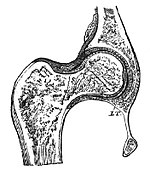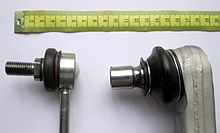Ball joint

In mechanical engineering and in anatomy, a ball joint is a joint in which the joint head has a ball-like shape. The counterpart, which encloses the head to different degrees depending on the joint, is called the joint socket or ball socket . Due to this geometry, a ball joint can in principle be rotated in three axes. Translational movements are not possible.
anatomy
An example of a ball joint in anatomy is the shoulder joint ( articulatio humeri ). A special form of the ball joint is the nut joint ( Enarthrosis spheroidea ). In this, the joint socket surrounds the joint head beyond its equator . This restricts the amplitude of the movements . In mammals, the hip joint is designed in this way.
Although both ball and socket joints are basically multiaxial, this mobility can be largely restricted by the arrangement of the muscles . The shoulder joint in many quadruped mammals with their reduced shoulder girdle , which is constantly moving, can only move in one axis (flexion and extension).
Worn or damaged ball joints can be rebuilt as an endoprosthesis made of metal or ceramic and used surgically.
technology

on the left: coupling rod to the stabilizer
on the right: ball joint
In vehicle technology , ball joints are used in particular for wheel suspension and steering , where components connected to one another rotate around all three spatial axes. If there is little mobility, elastically deformable rubber bearings are used.
Application in vehicle construction:
- Ball joint - Connects the wishbone to the wheel carrier
- Tie rod end - connects the tie rod with the wheel carrier
- Coupling rod connects the stabilizer with a handlebar or the wheel carrier via ball joints or rubber bearings
Other uses:
- Ball joint head of a tripod in film and photo technology
The king pin of the fifth wheel of a semi-trailer or the ball head of the trailer coupling of a car has the same freedom of movement as a ball joint, but can be separated.
